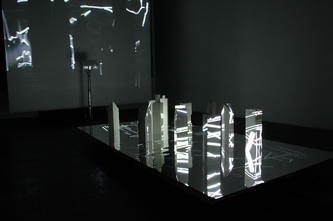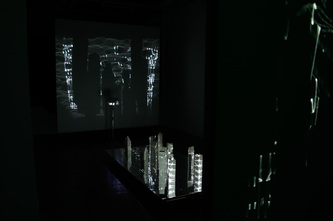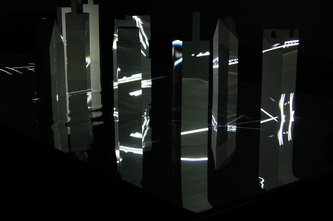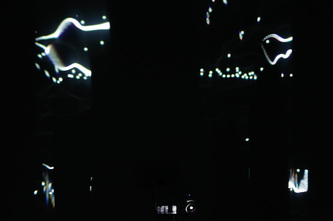Kukai: Sea and Sky, 2012 (collaboration with Yuki Nakamura)
porcelain, Mylar, paper, wood, 2-channel video projection, audio
dimensions variable
SOIL Gallery, Seattle, WA
porcelain, Mylar, paper, wood, 2-channel video projection, audio
dimensions variable
SOIL Gallery, Seattle, WA
A Body Like an Ocean
After Japan’s Tsunami: Porcelain, Animation, Sound, and Mylar
(excerpt of review by Jen Graves)
“Ravishing” was the word I had to use the last time I experienced a digital animation rising and setting over a tiny ceramic city in a darkened gallery by the artists Robert Campbell and Yuki Nakamura. That was in 2006, and a new installation based on a similar structure remains beyond the need for or quite the reach of description, especially the way it rolls through time, waves of light patterns passing across faceted and reflecting surfaces in a dazzling stream of constant change.
But certain pieces of information open up new associations. The artists live across Puget Sound from each other, on facing rocks: Campbell on Vashon Island and Nakamura (who is originally from Japan) in Old Town Tacoma. Their mutual view is like an infinite mirrored regress. The artists have written that since the tsunami hit Japan, when they look out at the ships and detritus drifting between them, they can’t help but think about bits and pieces of people’s homes—which are, in fact, making their way toward the American West Coast.
While the artists’ 2006 collaboration,Floating Plaster/City Motion, was founded on hard chunks of land—Nakamura’s sculptures, on which Campbell’s animations appeared, were shaped after the footprints of the Île Saint-Louis and the Île de la Cité in Paris—their new installation has no such anchor. Everything is unmoored. It is called Kūkai: Sea and Sky.
Neon colors animated the sci-fi urbanism of Floating Plaster/City Motion, but Kūkai (a reference to an influential 8th- century Japanese Buddhist monk) is sparkling white, black, and shadow only. The “show” of the animations passing across the porcelain sculptures is multiplied in three other flat surfaces: the pedestal, covered in Mylar, which creates a reflected underworld, and full-height walls built at both ends of the pedestal, where watery afterimages of the Mylar reflections jump and float. A soundtrack adds still another shifting dimension.
Naturally, there’s a memorial quality to Kūkai. The only bodies are the porcelain sculptures, small, refined monuments that are not monoliths but appear to be parts joined together at tight, neat seams—holding fast while their reflections shiver and mutate.
After Japan’s Tsunami: Porcelain, Animation, Sound, and Mylar
(excerpt of review by Jen Graves)
“Ravishing” was the word I had to use the last time I experienced a digital animation rising and setting over a tiny ceramic city in a darkened gallery by the artists Robert Campbell and Yuki Nakamura. That was in 2006, and a new installation based on a similar structure remains beyond the need for or quite the reach of description, especially the way it rolls through time, waves of light patterns passing across faceted and reflecting surfaces in a dazzling stream of constant change.
But certain pieces of information open up new associations. The artists live across Puget Sound from each other, on facing rocks: Campbell on Vashon Island and Nakamura (who is originally from Japan) in Old Town Tacoma. Their mutual view is like an infinite mirrored regress. The artists have written that since the tsunami hit Japan, when they look out at the ships and detritus drifting between them, they can’t help but think about bits and pieces of people’s homes—which are, in fact, making their way toward the American West Coast.
While the artists’ 2006 collaboration,Floating Plaster/City Motion, was founded on hard chunks of land—Nakamura’s sculptures, on which Campbell’s animations appeared, were shaped after the footprints of the Île Saint-Louis and the Île de la Cité in Paris—their new installation has no such anchor. Everything is unmoored. It is called Kūkai: Sea and Sky.
Neon colors animated the sci-fi urbanism of Floating Plaster/City Motion, but Kūkai (a reference to an influential 8th- century Japanese Buddhist monk) is sparkling white, black, and shadow only. The “show” of the animations passing across the porcelain sculptures is multiplied in three other flat surfaces: the pedestal, covered in Mylar, which creates a reflected underworld, and full-height walls built at both ends of the pedestal, where watery afterimages of the Mylar reflections jump and float. A soundtrack adds still another shifting dimension.
Naturally, there’s a memorial quality to Kūkai. The only bodies are the porcelain sculptures, small, refined monuments that are not monoliths but appear to be parts joined together at tight, neat seams—holding fast while their reflections shiver and mutate.





